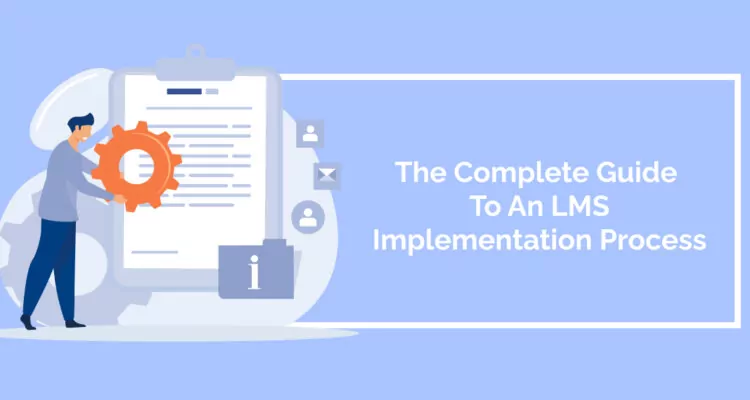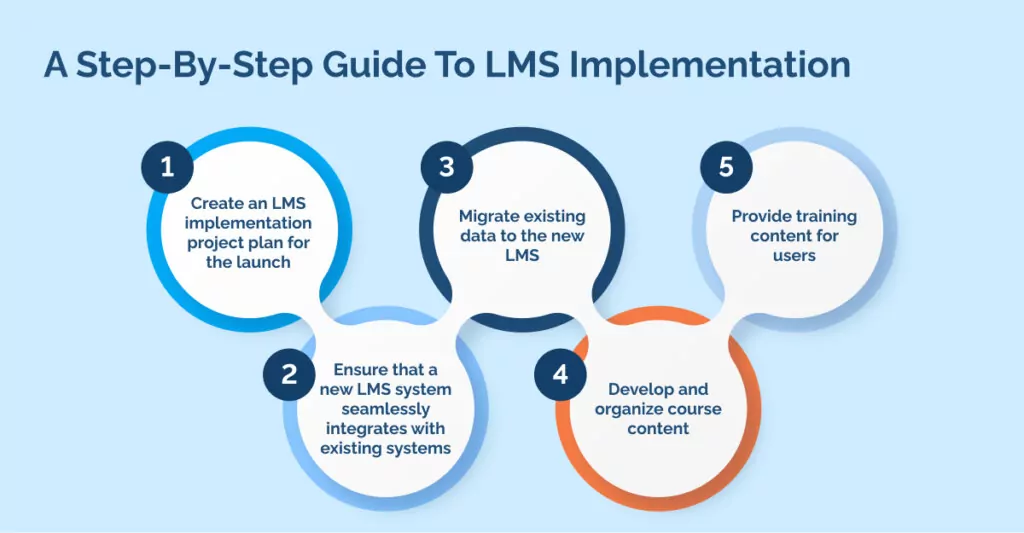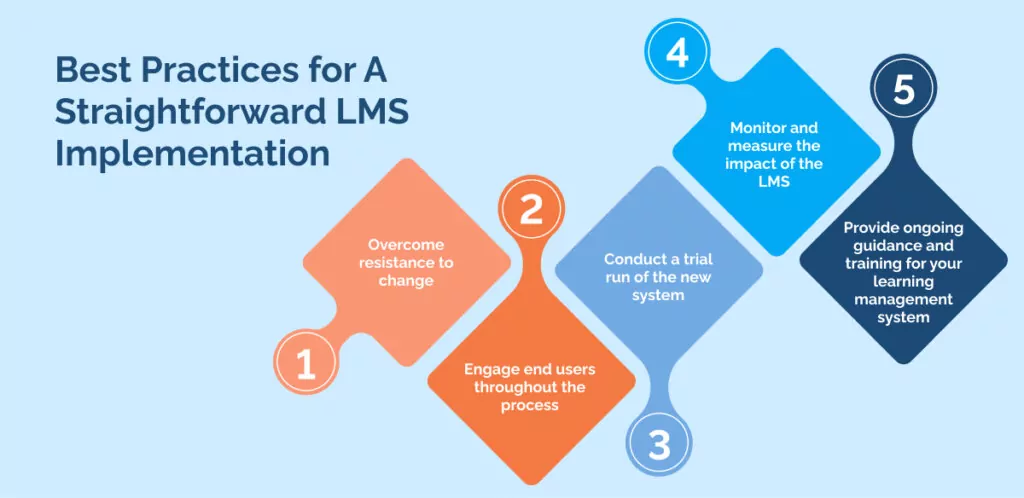
An LMS, short for Learning Management System, is a digital platform designed to facilitate the creation, delivery, and monitoring of training programs and courses.
Implementing an LMS within an organization is more than selecting and populating the correct software with content. It’s a comprehensive process that calls for clear objectives, meticulous planning, continuous evaluations, and numerous data-driven decisions.
Introducing an LMS into an organization’s digital landscape can be the most challenging step for companies venturing into online learning as it means integrating the LMS into the company’s existing tech framework.
The key is to ensure the corporate learning management system is user-friendly for everyone involved, from the participants in the training program to the administrators overseeing its progress.
A successful LMS integration demands a well-thought-out strategy and precise execution to tailor the system to your unique training aspirations.
The diligence pays off; a well-implemented LMS can simplify online education delivery, optimize the distribution of training resources, and offer insights into learner achievements.
By the end of this guide, you will understand:
- What is an LMS?
- What is LMS implementation?
- The critical factors for an LMS implementation
- The steps you need to take to ensure a successful LMS implementation
- The best practices for implementing an LMS within your organization
What Is An LMS?

A Learning Management System (LMS) is a digital platform that facilitates the administration, tracking, reporting, and delivery of educational courses or training programs.
Corporate learning management systems (LMS) are essential for organizations to manage their on-demand user education programs effectively.
It allows a business to possess a centralized platform to create, deliver, and monitor employee training resources for their employees, clients, and partners.
It functions similarly to a shared drive like Google Drive, Dropbox, or a customer relationship management (CRM) system.
However, in the context of learning management systems, it empowers learning managers to develop educational curricula, assess employee performance through testing and grading, and keep track of their proficiency levels.
Learning Management System (LMS) platforms are advantageous in various scenarios, including product-led enterprises that stimulate growth by involving freemium users or organizations aiming to educate their employees on the functionality and processes of their (new) tools and workflows.
What Is an LMS Implementation Process?
The process of implementing an LMS involves the deployment of a fresh learning management system, the integration of educational content, and the establishment of controls, user accounts, and customized settings prior to its activation.
By doing so, an LMS empowers an organization to:
Housing educational materials in a single location
A learning management system is a centralized platform for housing all educational content, encompassing video tutorials, electronic documents, slide presentations, manuals, instructional guides, interactive evaluations, and examinations.
Monitoring learner engagement and progress
Rather than making the automatic assumption that your employees are receiving the necessary guidance, a learning management system enables you to monitor their completion of courses and their past performance, as well as recommend tailored assessments and learning routes.
Offering a financially viable training approach
The primary advantage of an LMS system over alternative employee training methods such as individual coaching, webinars, and classroom lectures lies in its SaaS-based nature. This characteristic means that it is more cost-effective compared to other learning strategies.
Through a subscription, numerous employees, partners, and clients can be empowered to access courses at their convenience, undertake personalized assessments, receive immediate grading, and monitor their past performance.
Providing employees unrestricted access to eLearning resources enhances their flexibility in undertaking courses through smartphones or during their commute to work, as opposed to attending traditional classroom lectures.
This increased flexibility significantly boosts the likelihood of employees actively engaging with the learning materials, even if their involvement is primarily passive.
Essential Factors to Consider for An LMS Implementation Process

A learning management system is a supplementary cognitive tool housing your company’s educational framework.
So, here are the factors that are important when implementing an LMS within your organization:
Consider your business goals and objectives
Businesses seeking a learning platform want to transition from their current solution or migrate from various learning and education workflow tools, such as Airtable, Notion, and others.
They aim to consolidate these tools into a single, reliable source to centralize their internal education infrastructure.
Regardless of the scenario, it is crucial to identify the precise issue or a combination of challenges that a learning management system is intended to address, such as:
- A centralized source for all learning materials, including videos, tutorials, courses, case studies, presentations, and curated learning journeys.
- Interactive quizzes, tests, and tasks that offer immediate feedback and grading.
- A tool to measure organizational performance to get a user’s historical progress benchmarks them against their colleagues and recommends tailored learning routes for skill enhancement.
- AI-driven educational support that creates tests and recommends individualized learning routes, resources, and activities, considering a user’s background, position, challenges, and proficiencies.
Identify your end user needs and expectations
Learners and their supervisors are vital stakeholders in the process. With them, the focus is on pinpointing training needs, not just objectives. Engage in genuine dialogue with your potential learners.
Inquire about areas where they feel they might lack skills or knowledge.
Opt for informal discussions over formal surveys, as the latter can inadvertently prompt inaccurate responses due to fears of repercussions for admitting gaps in knowledge.
By fostering a candid environment, you can more accurately identify and address training necessities.
Choose an appropriate LMS vendor
Selecting the right LMS vendor hinges on its alignment with your organization’s needs. Pinpoint essential features and capabilities that resonate with your business objectives.
Beyond that, consider user-friendliness, adaptability, analytics, integration capabilities, and content handling.
Engage in demonstrations and test runs with prospective LMS providers. Including crucial stakeholders and pertinent departments in this assessment phase is beneficial, ensuring a comprehensive evaluation through their input.
Put together your implementation team
Your LMS core team should comprise technical experts from your LMS provider and your organization.
This team must collaborate from the get-go, enabling them to assist in the following ways:
- Develop a strong LMS implementation blueprint.
- Design an induction process to familiarize your staff and administrators with the LMS functionalities.
- Pinpoint key performance indicators to ensure the project remains on course.
- Discover avenues to enhance the LMS through external integrations and bespoke applications.
- Outline a timeline, highlight critical phases, and monitor the progression of LMS introduction.
- Configure user accounts, curate course material, and manage user analytics, among other tasks.
While your rollout team should be diverse, representing different facets of your organization, unity in decision-making and mutual respect for varied viewpoints are essential throughout the implementation process.
Develop a project plan and timeline
Your LMS rollout strategy is a foundational guide for every subsequent phase of the LMS introduction, encompassing team formation, data migration, and more.
Clarifying your LMS objectives provides a clear roadmap for its rollout, such as:
- Selecting the right LMS provider from the various options available.
- Recognizing educational requirements, pinpointing areas where your employees (or clients, partners, etc.) need training, and deciding the most effective content format for each scenario.
- A comprehensive strategy for infusing your LMS with course materials, activities, educational resources, and evaluations. Will you integrate external content or produce your own?
Additionally, assigning specific timeframes to each task is crucial. Regularly revisiting your plan ensures you remain aligned with your objectives, enabling timely adjustments and preventing unforeseen hold-ups.
A Step-By-Step Guide To LMS Implementation

Within a learning management system, you can oversee the e-learning journey, house assets like videos, product manuals, and explanatory content, evaluate stakeholders and assess their achievements.
To make the implementation process easier, here are the steps needed to have a successful LMS implementation process:
Create an LMS implementation project plan for the launch
Implementing an LMS requires a comprehensive project management approach with distinct timelines and target dates.
Begin by setting a launch date for your LMS. From there, backtrack to identify critical milestones to meet this launch objective.
Designate specific deadlines for each milestone, ensuring the team remains accountable and the workload is segmented into feasible portions.
Transparent timelines also assist in formulating a pragmatic budget and earmarking the requisite resources for seamless execution.
A well-structured plan not only reinforces accountability but also keeps the team focused, steering the project towards the envisioned results.
Ensure that a new LMS system seamlessly integrates with existing systems
To ensure a new Learning Management System (LMS) seamlessly integrates with existing systems, it is imperative to meticulously assess the compatibility and interoperability of both the new LMS and the existing systems.
A detailed analysis of existing systems should be performed to identify potential areas of integration, such as user authentication, data synchronization, and content management.
This process should involve close collaboration between the learning management system implementation team and the IT department responsible for the existing systems.
Furthermore, a thorough understanding of the technical specifications and requirements of the existing systems is crucial to developing a seamless integration plan.
By adhering to these measures, the successful integration of the new LMS with the existing systems can be achieved, ensuring a smooth transition and optimal functionality for all stakeholders involved.
Migrate existing data to the new LMS
When transitioning to a new CRM, HCM, or any enterprise software, the challenges are aplenty, from dealing with varying data structures to navigating non-matching infrastructures.
So, to ensure a successful implementation, you should:
- Align your current LMS’s features and data sources with their respective locations in the new system.
- Refine your data: categorize, arrange, remove redundant entries, and optimize where required.
- Sample a selection of courses and activities within your new LMS to ensure they function as intended.
- Evaluate relevant functionalities, including mobile compatibility, grading mechanisms, course monitoring, and competitive leaderboards.
Think of an LMS as your organization’s digital cortex, with data being its treasured experiences. Safeguarding this data, ensuring its quality, and rigorously testing it are paramount for maintaining its integrity.
Develop and organize course content
Developing and organizing course content is critical to an LMS implementation phase. It involves carefully planning and structuring the material to ensure that it aligns with the relevant training objectives and needs of the target audience.
This process requires a systematic approach, starting with conducting a thorough analysis of the subject matter and identifying the key concepts and skills that need to be covered.
Additionally, incorporating various instructional strategies, such as lectures, discussions, and hands-on activities, can enhance engagement and promote active e-learning.
Developing and organizing course content requires meticulous attention to detail and a deep understanding of the subject matter to create a meaningful and impactful learning experience for students.
Provide training content for users
Before rolling out your LMS, educating your learners on its usage is crucial. Ensure that every user knows how to log in and navigate the platform so they can effortlessly access the educational content.
Equally vital is the online training of those overseeing the LMS, ensuring they are well-versed in its functionalities and their managerial responsibilities.
Here are some methods to facilitate LMS training:
- Host Training Sessions: Consider organizing either individual or a series of online training sessions. Aim to make these sessions engaging and interactive, fostering a positive learning environment where attendees feel empowered to use the LMS confidently.
- Offer Continued Support and Materials: This is especially crucial when there are updates to the LMS or shifts in content strategy. Ensure users always have access to up-to-date resources like training videos.
- Boost User Engagement and Uptake: Think about introducing incentives within your organization. Whether it’s rewards, recognitions, or competitions, motivating factors can greatly enhance the enthusiasm and adoption of the LMS.
Best Practices for A Straightforward LMS Implementation

Launching a new LMS and ensuring it delivers value right out of the gate can be challenging, but it doesn’t need to be daunting.
To create a seamless LMS implementation, here are some best practices recommended by us:
Overcome resistance to change
Navigating change can be challenging for many organizations. Breakthroughs often trigger resistance, apprehension, and doubts. To mitigate resistance to change, it’s pivotal for entities to devise a strategy that emphasizes communication and adaptability. Here’s a suggested approach:
- Draft a Change Management Blueprint: Begin by delineating key tactics, tasks, and resources that will facilitate a smooth transition.
- Foster Robust Communication: It’s crucial to ensure organizational alignment. Establish consistent communication channels; perhaps launch a platform like Slack or set up a dedicated discussion forum, enabling team members to interact seamlessly.
- Confront Resistance Proactively: There will likely be segments of your organization wary of the new LMS. It’s essential to confront this apprehension. Recognize their feelings, then illuminate the advantages of the new system. Highlight its positive implications for both individual roles and the broader organizational goals. Should resistance persist, think about offering supplementary training and support.
Engage end users throughout the process
Concentrate on creating an engagement strategy that continually ignites enthusiasm and promotes widespread use of the new LMS. Utilize intriguing teasers, interactive games, and incentives to captivate your learners.
Emphasize how new learning opportunities presented can empower users to enhance their skills and achieve their personal growth targets.
Weave these engagement methods throughout the integration journey, allowing users to gradually acquaint themselves with the system rather than plunging in headfirst.
For instance, you could roll out an “LMS Launch Quest” where users tackle specific training sessions during the setup phase to earn rewards. Additionally, facilitate live Q&A sessions to address queries and showcase the LMS’s features.
Nurturing a keen interest in the LMS is crucial for successful onboarding, boosting involvement, and fostering a culture of continuous education in the organization. It can also result in a positive user experience as it can continually convey the value of the LMS and the direct benefits it stands to gain.
Conduct a trial run of the new system
Before fully launching the LMS, initiate a trial run with a diverse group of learners. Solicit their insights regarding the system’s user-friendliness, the training platform’s efficacy, and any difficulties they encountered.
Collect their training need perspectives using methods like surveys, focus group sessions, or one-on-one interviews. If subject matter experts (SMEs) develop e-learning modules, evaluate the duration and ease of content creation within the system.
Compile all feedback and utilize it to finetune the LMS prior to its official release. Considering peer reviews ensures that you can identify and rectify challenges, make necessary tweaks, and integrate valuable recommendations for a more seamless launch.
Monitor and measure the impact of the LMS
After a successful launch of the LMS, it’s crucial to assess the process’s effectiveness and the experiences of all participants. Identify and rectify any technical issues that might have impacted the launch.
Moreover, as you conclude your LMS rollout, undertake the following evaluations:
Measure user engagement by checking the number of logins and their navigation patterns. Did they finish the courses? What were their scores?
While scores and user satisfaction offer a glimpse, they only partially depict the LMS’s alignment with organizational objectives.
However, in the early stages, these metrics shed light on the system’s technical robustness, including aspects like page load times, upload durations, and the overall user journey.
Additionally, consistently collect real-time feedback to uphold the LMS’s efficiency and cater to the organization’s changing demands. Incorporate feedback mechanisms such as surveys and digital suggestion forums, encouraging users to relay their experiences.
Leverage this feedback to address user issues and prioritize system refinements. Track essential metrics and benchmarks to evaluate the LMS’s influence on training aims, ensuring you derive the utmost benefit from your LMS. In doing so, you’ll foster an environment of continuous improvement and ongoing enhancement across the organization.
Provide ongoing guidance and training for your learning management system
An in-app experiences tool helps users navigate the intricacies of the learning management system’s interface, allowing them to explore courses, tests, and exercises through comprehensive walkthroughs and providing instant access to help.
These onboarding utilities enhance the learner’s experience by enabling them to:
- Find relevant LMS documentation, tutorials, and explanatory materials directly within the interface.
- Familiarize themselves with functionalities through interactive product journeys.
- Receive timely advice, insights, and pointers through tooltips and user experience markers.
- Retrieve valuable resources in their language of choice.
Furthermore, adopting role-specific onboarding ensures learners receive content tailored to their specific roles and requirements.
Final Word On LMS Implementation
An LMS is a form of HR technology that can deliver, manage, and observe the effectiveness of employee training.
The journey of LMS implementation doesn’t conclude with its launch. Continuously seek opportunities to enhance the system, refine content, introduce new courses, and elevate the user experience throughout the LMS’s lifecycle.
Incorporating an LMS into a multifaceted environment is bound to bring forth certain challenges. Anticipating these issues can assist organizations in managing them adeptly.
Typical challenges encompass organizational reluctance towards change, leaders being daunted by novel technology, and doubts regarding the advantages of employing an LMS.
Nevertheless, with effective communication, appropriate training, and a well-structured LMS rollout strategy, many obstacles can be easily surmounted.
WalkMe Team
WalkMe spearheaded the Digital Adoption Platform (DAP) for associations to use the maximum capacity of their advanced resources. Utilizing man-made consciousness, AI, and context-oriented direction, WalkMe adds a powerful UI layer to raise the computerized proficiency, everything being equal.



